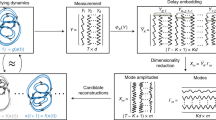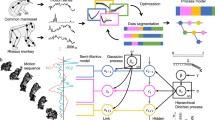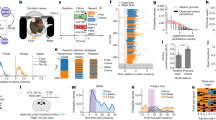Abstract
Neuroscientists and roboticists alike are interested in how both the external cues and internal states contribute to determining behavioral sequences. As the motivation drivers change through time, so does the animal switch between alternating activities and outward exhibition of patterned behavior. It is accepted that underlying neural integration of internal states - as well as incoming information of the external environment - give rise to the adaptive abilities of animal behavior in different contexts. Here, the sequences of hunting-motivated behavior of praying mantises were modeled as Markov chains, with each sequence giving rise to a corresponding transition probability matrix. From these transition matrices, three methods of prototype generation were used - cumulative, centroid, and medoid - to produce categorical representatives of the time series data of all five feeding states used in the experiments. Novel to this paper, is the use of Markovian chain metrics to compare the efficacy of these prototypes at capturing the time-evolution behavior unique to each feed state. Results show that the cumulative prototypes best exhibited temporal behaviors most consistent with the real data.
Access this chapter
Tax calculation will be finalised at checkout
Purchases are for personal use only
Similar content being viewed by others
References
Aghabozorgi, S., Wah, T., Amini, A., Saybani, M.: A new approach to present prototypes in clustering of time series. In: The 7th International Conference of Data Mining, vol. 28, no. 4, pp. 214–220 (2011). http://cerc.wvu.edu/download/WORLDCOMP’11/2011CDpapers/DMI2163.pdf%5Cn. http://cerc.wvu.edu/download/WORLDCOMP’11/2011CDpapers/DMI2163.pdf%5Cn. http://www.lidi.info.unlp.edu.ar/WorldComp2011-Mirror/DMI2163.pdf
Alger, S.J., Larget, B.R., Riters, L.V.: A novel statistical method for behaviour sequence analysis and its application to birdsong. Anim. Behav. 116, 181–193 (2016). https://doi.org/10.1016/j.anbehav.2016.04.001. https://doi.org/10.1016/j.anbehav.2016.04.001
Bishop, C.M.: Pattern Recognition and Machine Learning (Information Science and Statistics). Springer-Verlag, Berlin, Heidelberg (2006)
Ermon, S., Gomes, C.P., Sabharwal, A., Selman, B.: Designing fast absorbing Markov chains. https://www.aaai.org
Hunter, J.J.: Mixing times with applications to perturbed Markov chains. Linear Alg. Appl. 417, 108–123 (2006). https://doi.org/10.1016/j.laa.2006.02.008. www.elsevier.com/locate/laa
Johnson, N., Galata, A., Hogg, D.: The acquisition and use of interaction behaviour models. In: Proceedings 1998 IEEE Computer Society Conference on Computer Vision and Pattern Recognition (Cat. No. 98CB36231), pp. 866–871 (1998). https://doi.org/10.1109/CVPR.1998.698706
Kershenbaum, A., Garland, E.C.: Quantifying similarity in animal vocal sequences: which metric performs best? Methods Ecol. Evol. 6(12), 1452–1461 (2015). https://doi.org/10.1111/2041-210X.12433
Leon-Alcaide, P., Rodriguez-Benitez, L., Castillo-Herrera, E., Moreno-Garcia, J., Jimenez-Linares, L.: An evolutionary approach for efficient prototyping of large time series datasets. Inf. Sci. 511, 74–93 (2020). https://doi.org/10.1016/J.INS.2019.09.044
Levin, D.A., Peres, Y., Wilmer, E.L.: Markov Chains and Mixing Times (Second Edition) (2017). https://search.ebscohost.com/login.aspx?direct=true &scope=site &db=nlebk &db=nlabk &AN=1627551
Pickard, S.C., Bertsch, D.J., Le Garrec, Z., Ritzmann, R.E., Quinn, R.D., Szczecinski, N.S.: Internal state effects on behavioral shifts in freely behaving praying mantises (Tenodera sinensis). PLOS Comput. Biolo. 17(12), e1009618 (2021). https://doi.org/10.1371/journal.pcbi.1009618
Author information
Authors and Affiliations
Corresponding author
Editor information
Editors and Affiliations
Rights and permissions
Copyright information
© 2022 The Author(s), under exclusive license to Springer Nature Switzerland AG
About this paper
Cite this paper
Pickard, S.C. (2022). Time-Evolution Characterization of Behavior Class Prototypes. In: Hunt, A., et al. Biomimetic and Biohybrid Systems. Living Machines 2022. Lecture Notes in Computer Science(), vol 13548. Springer, Cham. https://doi.org/10.1007/978-3-031-20470-8_38
Download citation
DOI: https://doi.org/10.1007/978-3-031-20470-8_38
Published:
Publisher Name: Springer, Cham
Print ISBN: 978-3-031-20469-2
Online ISBN: 978-3-031-20470-8
eBook Packages: Computer ScienceComputer Science (R0)




